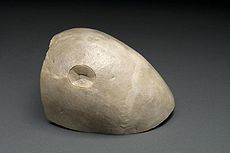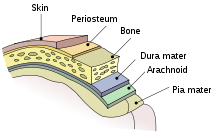- Skull fracture
-
Skull fracture Classification and external resources 
A piece of a skull with a depressed skull fractureICD-10 S02 ICD-9 800.0-804.9 MeSH D012887  Mind map showing a summary of skull fractures.
Mind map showing a summary of skull fractures.
A skull fracture is a break in one or more of the bones in the skull usually occurring as a result of blunt force trauma. If the force of the impact is excessive the bone may fracture at or near the site of the impact. The force of direct impact may cause damage to the underlying physical structures contained within the skull such as the membranes, blood vessels, and brain, even in the absence of a fracture. While an uncomplicated skull fracture can occur without associated physical or neurological damage and is in itself usually not clinically significant, a fracture in healthy bone indicates that a substantial amount of force has been applied and increases the possibility of associated injury. Any significant blow to the head results in a concussion, with or without loss of consciousness.
A fracture which occurs in conjunction with an overlying laceration which tears the epidermis and the meninges or runs through the paranasal sinuses and the middle ear structures, resulting in the outside environment being in contact with the cranial cavity is termed a compound fracture. Compound fractures may either be clean or contaminated.
There are four major types of skull fractures; linear fractures which are the most common and usually require no intervention for the fracture itself, depressed fractures which are usually comminuted with broken portions of bone displaced inward may require surgical intervention if there is underlying tissue damage, diastatic fractures in which the sutures of the skull widen usually affects children under three, and basilar fractures which occur in the bones at the base of the skull.
Contents
Linear fracture
Linear skull fractures are breaks in the bone that transverse the full thickness of the skull from the outer to inner table, are usually fairly straight and involve no displacement of the bone. The common method of injury is blunt force trauma in which the energy from the blow is transferred over a wide surface area of the skull.
Linear fractures of the skull are usually of little clinical significance unless they parallel in close proximity or transverse a suture, or they involve a venous sinus groove or vascular channel. The resulting complications may include suture diastasis, venous sinus thrombosis, and epidural hematoma. In young children although rare the possibility exists of developing a growing skull fracture especially if the fracture occurs in the parietal bone.[1]
Depressed skull fracture
A depressed skull fracture is a type of fracture usually resulting from blunt force trauma, such as getting struck with a hammer, rock or getting kicked in the head. These types of fractures, which occur in 11% of severe head injuries, are comminuted fractures in which broken bones are displaced inward. Depressed skull fractures carry a high risk of increased pressure on the brain, crushing the delicate tissue.
Compound depressed skull fractures occur when there is a laceration over the fracture, resulting in the internal cranial cavity being in contact with the outside environment increasing the risk of contamination and infection. Complex depressed fractures are those in which the dura mater is torn. Depressed skull fractures may require surgery to lift the bones off the brain if they are placing pressure on it.[2]
Diastatic skull fracture
Diastatic fractures occur when the fracture line transverses one or more sutures of the skull causing a widening of the suture. While this type of fracture is usually seen in infants and young children as the sutures are not yet fused it can also occur in adults. When a diastatic fracture occurs in adults it usually affects the lamboidal suture as this suture does not fully fuse in adults until about the age of 60.
Diastatic fractures can occur with different types of fractures and it is also possible for diastasis of the cranial sutures to occur without a concomitant fracture. Sutural diastasis may also occur in various congenital disorders such as cleidocranial dysplasia and osteogenesis imperfecta.[3][4][5][6]
Basilar skull fracture
Main article: Basilar skull fractureBasilar skull fractures, breaks in bones at the base of the skull, require more force to cause than cranial vault fractures. Thus they are rare, occurring as the only fracture in only 4% of severe head injury patients.
Basilar fractures have characteristic signs: blood in the sinuses; a clear fluid called cerebrospinal fluid (CSF) leaking from the nose (rhinorrhea) or ears (otorrhea); periorbital ecchymosis or "raccoon eyes" (bruising of the orbits of the eyes that result from blood collecting there as it leaks from the fracture site); and retroauricular ecchymosis or "Battle's sign" (caused when blood collects behind the ears and causes bruising).
Growing skull fracture
A growing skull fracture (GSF) also known as a craniocerebral erosion or leptomeningeal cyst due to the usual development of a cystic mass filled with cerebral spinal fluid is a rare complication of head injury usually associated with linear skull fractures of the parietal bone in children under 3. It has been reported in older children in atypical regions of the skull such as the basiooccipital and the base of the skull base and in association with other types of skull fractures. It is characterized by a diastatic enlargement of the fracture.
There are various factors associated with the development of a GSF with the primary causitive factor being a tear in the dura mater. The skull fracture enlarges due in part to the rapid physiologic growth of the brain which occurs in young children and brain cerebrospinal fluid (CSF) pulsations in the underlying leptomenigeal cystic mass. [7][8][9][10][11][12][13]
Cranial burst skull fracture
A cranial burst skull fracture usually occurring with severe injuries in infants less than 1 year of age is a closed, diastatic skull fracture with cerebral extrusion beyond the outer table of the skull under the intact scalp.
Acute scalp swelling is associated with this type of fracture. In equivacal cases without immediate scalp swelling the diagnosis may be made via the use of Magnetic resonance imaging thus insuring more prompt treatment and avoiding the development of a "growing skull fracture".[14]
Compound skull fracture
A fracture which occurs in conjunction with an overlying laceration which tears the epidermis and the meninges or runs through the paranasal sinuses and the middle ear structures, resulting in the outside environment being in contact with the cranial cavity is termed a compound fracture.
Compound fractures may either be clean or contaminated. Intracranial air (pneumocephalus) may occur in compound skull fractures.[15]
The most serious complication of compound skull fractures is infection. Increased risk factors for infection include visible contamination, meningeal tear, loose bone fragments and presenting for treatment more than eight hours after initial injury.[16]
Compound elevated skull fracture
case of blunt force trauma, a rotation of the skull while striking an inanimate object as in a fall or it may occur during transfer of a patient after the initial compound head injury.[17][18]
Neurological deficits in skull fractures
The presence of a concussion or skull fracture in trauma patients without intracranial hemorrhage or focal neurologic deficits was indicated in long term cognitive impairments and emotional lability at nearly double the rate as those patients without either complication.[19]
In a study of emergency room patients suspected of having suffered closed head injuries, neuropsychological testing and computerized tomography (CT) scans came back with normal results. The patients did not differ in Closed head injury (CHI) scores as measured by the Glasgow Coma Scale (GCS).
Those with a skull fracture were shown to have "neuropsychological dysfunction, even in the absence of intracranial pathology or more severe disturbance of consciousness on the GCS".[20]
See also
- Le Fort facial fracture
- Facial fracture
- Mandibular fracture
References
- ^ Haar FL. Complication of linear skull fracture in young children. Am J Dis Child. 1975 Oct;129(10):1197-200. PMID 1190143
- ^ Singh J and Stock A. 2006. "Head Trauma." Emedicine.com. Retrieved on January 26, 2007.
- ^ Paterson CR, Burns J, McAllion SJ. Am J Med Genet. 1993 Jan 15;45(2):187-92.Osteogenesis imperfecta: the distinction from child abuse and the recognition of a variant form. PMID 8456801
- ^ Kanda M, Kabe S, Kanki T, Sato J, Hasegawa Y. Cleidocranial dysplasia: a case report No Shinkei Geka. 1997 Dec;25(12):1109-13. PMID 9430147
- ^ Sabini RC, Elkowitz DE. J Am Osteopath Assoc. 2006 Oct;106(10):600-4. Significance of differences in patency among cranial sutures.PMID 17122029
- ^ Pirouzmand F, Muhajarine N. Craniofac Surg. 2008 Jan;19(1):27-36. Definition of topographic organization of skull profile in normal population and its implications on the role of sutures in skull morphology. PMID 18216661
- ^ Gupta SK, Reddy NM, Khosla VK, Mathuriya SN, Shama BS, Pathak A, Tewari MK, Kak VK. Growing skull fractures: a clinical study of 41 patients. Acta Neurochir (Wien). 1997;139(10):928-32. PMID 9401652
- ^ Ersahin Y, Gülmen V, Palali I, Mutluer S. Growing skull fractures (craniocerebral erosion). Neurosurg Rev. 2000 Sep;23(3):139-44. PMID 11086738
- ^ Muhonen MG, Piper JG, Menezes AH. Surg Neurol. 1995 Apr;43(4):367-72; discussion 372-3. Pathogenesis and treatment of growing skull fractures.PMID 7792708
- ^ Caffo M, Germanò A, Caruso G, Meli F, Calisto A, Tomasello F. Acta Neurochir (Wien). 2003 Mar;145(3):201-8; discussion 208. Growing skull fracture of the posterior cranial fossa and of the orbital roof. PMID 12632116
- ^ Ziyal IM, Aydin Y, Türkmen CS, Salas E, Kaya AR, Ozveren F. Acta Neurochir (Wien). 1998;140(7):651-4. The natural history of late diagnosed or untreated growing skull fractures: report on two cases.PMID 9781277
- ^ Locatelli D, Messina AL, Bonfanti N, Pezzotta S, Gajno TM. Growing fractures: an unusual complication of head injuries in pediatric patients. Neurochirurgia (Stuttg). 1989 Jul;32(4):101-4. PMID 2770958
- ^ Pezzotta S, Silvani V, Gaetani P, Spanu G, Rondini G. J Neurosurg Sci. 1985 Apr-Jun;29(2):129-35. Growing skull fractures of childhood. Case report and review of 132 cases. PMID 4093801
- ^ Donahue DJ, Sanford RA, Muhlbauer MS, et al. Cranial burst fracture in infants: acute recognition and management. Childs Nerv Syst. 1995 Dec;11(12):692-7. PMID 8750951
- ^ Fundamentals of diagnostic radiology by William E. Brant, Clyde A. Helms p.56
- ^ Rehman L, Ghani E, Hussain A, et al. Infection in compound depressed fracture of the skull. J Coll Physicians Surg Pak. 2007 Mar;17(3):140-3. PMID 17374298
- ^ Elevated skull fracture[www.ijntonline.com/Dec07/abstracts/abs12.PDF]
- ^ Adeolu AA, Shokunbi MT, Malomo AO, et al. Compound elevated skull fracture: a forgotten type of skull fracture. Surg Neurol. 2006 May;65(5):503-5. PMID 16630918
- ^ Jackson JC. J Trauma. 2007 Jan;62(1):80-8. Long-term cognitive, emotional, and functional outcomes in trauma intensive care unit survivors without intracranial hemorrhage.PMID 17215737
- ^ Smith-Seemiller L. Brain Inj. 1997 Mar;11(3):191-6. Impact of skull fracture on neuropsychological functioning following closed head injury. PMID 9058000
Bibliography
- Forensic Neuropathology By Jan E. Leestma Publisher: CRC Press; 2 edition (October 14, 2008) Language: English ISBN 0849391679 ISBN 978-0849391675
- Neuroimaging: Clinical and Physical Principles By Robert A. Zimmerman, Wendell A. Gibby, Raymond F. Carmody Publisher: Springer; 1st edition (January 15, 2000) Language: English ISBN- 0387949631 ISBN 978-0387949635
External links
- Skull fractures at eMedicine
- Growing skull fracture at Medpix
- "Tutorial: CT in Head Trauma"
- Head Trauma at Emedicine.com
- Skull Fractures at MedPix
- After the Injury- Children's Hospital Of Philadelphia
Injury : Fractures and cartilage injuries (Sx2, 800–829) General Head Vertebral Spinal fractureRibs Shoulder, arm
and handShoulderArmHandHip, leg and foot Hip/femurLegFootCategories:- Bone fractures
- Neurotrauma
- Injuries of head
Wikimedia Foundation. 2010.




